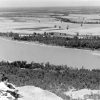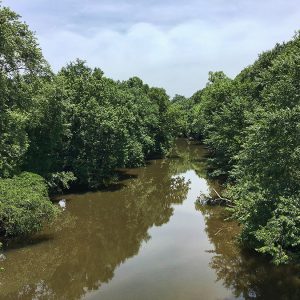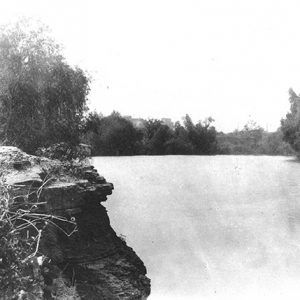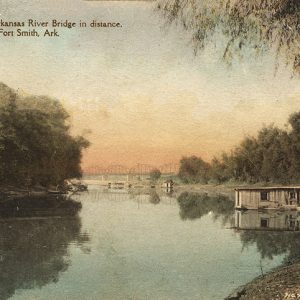calsfoundation@cals.org
Poteau River
The Poteau River rises in Arkansas from springs east of Waldron (Scott County) and flows westward for approximately thirty-nine miles before entering Le Flore County, Oklahoma. From there, the river continues to flow west until entering Wister Lake. Exiting the north side of the lake, the river flows northeast until finally emptying into the Arkansas River in Fort Smith (Sebastian County). The river flows for a total length of 141 miles.
Early inhabitants were located along the Poteau River during the Archaic, Woodland, and Mississippian eras. There are numerous archaeological sites located along the river, giving evidence indicating that the Caddo Indians once inhabited the area. The Poteau River and its banks served as hunting and fishing grounds for early native inhabitants. Prior to European exploration, herds of buffalo inhabited the river valley along the Poteau.
Throughout the late seventeenth and early eighteenth centuries, French trappers and traders traveled west from Arkansas Post along the Arkansas River. From there, they began traversing smaller tributaries, eventually making their way down the Poteau River in Scott County. The river carries the same name as the town of Poteau, Oklahoma. The river’s name is French in origin, meaning “post.” It is likely that a post or stake was planted near the mouth of the river as a marker, possibly as a trading concession.
The fertile river valley attracted early settlers to what is now western Arkansas. Considered Waldron’s first resident, William Grandison Featherston moved to the area in 1832 with his mother, wife, and four children. Featherston built a home along the river very close to where the Waldron train depot once stood. In 1836, Jackson Hon moved to Scott County with his family and several slaves. Hon had a log cabin built on the banks of the Poteau River in what is today the community of Hon, named after the Hon family. During the Civil War, Jackson Hon hid from occupying Union soldiers with his slaves in the Poteau River bottoms. Several additional communities were established along the Poteau River in western Scott County, including Bates, Coaldale, Weeks, Oliver, Evening Shade, and Cauthron.
The Poteau River has historically been prone to flooding. A particularly devastating flood occurred in the spring of 1845. Heavy rainfall over the course of several days caused the Poteau River to flood a large portion of the valley. The flood caused extensive damage to homes, crops, and livestock. Jackson Hon reported seeing nothing but water throughout the valley from the top of Poteau Mountain. Downtown Waldron had been especially vulnerable to flooding since the town’s incorporation. Road improvement and the installation of bridges helped flooding conditions along the Poteau. In 1914, the first constructive road-building campaign was started by Judge A. F. Smith. Several steel bridges were erected throughout the county, including along the Poteau River.
During settlement and for many subsequent years, farmers depended on the fertile lands along the Poteau to grow a variety of crops, including corn, cotton, beans, radishes, and strawberries. Hay production was also historically important along the river valley. By the twenty-first century, crop production had vanished to be replaced by cattle and chicken farms.
The muddy waters of the Poteau serve as a popular waterway for canoeists, fishermen, and swimmers. Fish species include largemouth bass, sun perch, catfish, buffalo, carp, and gar.
For additional information:
Cross, Frank Bernard, and George A. Moore. “The Fishes of the Poteau River, Arkansas and Oklahoma.” The American Midland Naturalist 47 (March 1952): 396–412.
Goodner, Norman. A History of Scott County, Arkansas. Siloam Springs, AR: Bar D Press, 1941.
McCutcheon, Henry Grady. History of Scott County, Arkansas. Little Rock: H. G. Pugh and Company, 1922.
Wright, Muriel H. “Some Geographic Names of French Origin in Oklahoma.” Chronicles of Oklahoma 7 (June 1929): 188.
Ty Richardson
Richardson Preservation Consulting


 Poteau River
Poteau River  Poteau River
Poteau River  Poteau River at Fort Smith
Poteau River at Fort Smith 



I was a four-year-old cotton sharecropper’s son in the 1930s in the Arkansas/Poteau River Bottoms. Seems I recall the Poteau actually running backward once when the Arkansas River was in high flood stage from from Rocky Mountain snow melt.